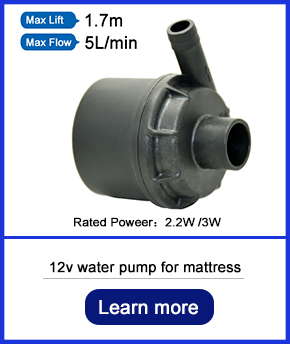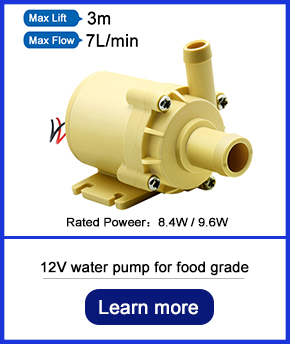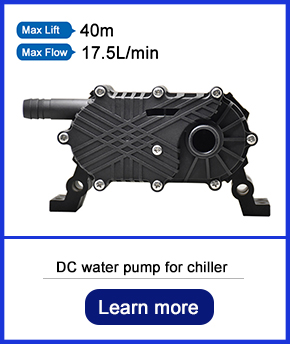 |  |  |
1. What is a Water Transfer Pump? Core Principles & Key Parameters
A water transfer pump moves liquids using mechanical force, based on centrifugal or positive displacement principles. Key parameters:
a. Flow Rate (GPM/L/min): Determine throughput (typically ≥ 80 L/min in new energy scenarios)
b. Head (m/ft): Max vertical lift (high-pressure models up to 150m)
c. Suction Lift (m): Max self-priming depth (DC pumps ≤5m)
d. Voltage (V): 12V/24V/36V DC (for energy storage), 380V AC (industrial)
Formula: Head = dynamic head + static head + friction loss (calculated via Darcy-Weisbach equation)
2. Selection Criteria for 2025 Scenarios
a. DC Voltage Scenarios Match Table
Application | Voltage | Key Requirements | Case Example |
Battery Cooling | 24V | 100+ L/min flow, 20-30m head | Tesla energy storage pump (12V/24V) |
Smart Toilet | 12V | ≤40dB noise, ≥54/min Max Flow | Kohler smart toilet pump (12V DC) |
Maintenance | 36V | ≥92% efficiency, IP67 rating | Huawei Kunpeng server pump (36V) |
b. DC Pump Selection Formula (Energy Storage)
Q = (Heat Load kW × 3600) ÷ (Coolant Cp × ΔT × Density)Example: 50kW heat load, ethylene glycol (Cp=4.2kJ/kg·℃, density=1070kg/m³), ΔT=5℃Q = (50×3600) ÷ (4.2×5×1070) ≈ 7.84 m³/h = 130.7 L/min
3. Deep answers to high-frequency problems
Q1: Can a 12V DC pump be used in high-pressure liquid cooling?
Yes, with:
a. Pressure booster module (up to 8 bar)
b. DC-DC converter (12V→24V step-up)
c. Case: 50m head achieved in energy storage with 12V pump + valve
Q2: How to calculate DC pump energy consumption?
Formula:kWh = Power(W) × Hours ÷ 1000
Efficiency adjustment: Actual power = Nominal power / Efficiency (e.g., 200W ÷ 0.9 = 222W)
Q3: DC vs AC pump maintenance differences?
Item | DC Pump (12V/24V/36V) | AC Pump (220V/380V) |
Wear Parts | Brushes (brushless dc motor 20000h) | Contactor (5000 cycles) |
Waterproof | IP67 (immersion cooling) | IP54 (splash-proof) |
Maintenance | Quarterly brush check | Annual lubrication |
Q4: How to prevent cavitation in server pumps?Three Steps:
a. Suction pipe ≥2x pump inlet diameter
b. Install NPSH sensor (set ≥3m)
c. Use deionized water coolant
Q5: Can 12V pump work with 24V power supply?
No. Direct connection will overload and potentially burn out the motor. Use a step-down module (e.g., DC-DC converter) to reduce 24V to 12V first.
Q6: How to improve liquid cooling pump efficiency?
a. Match parameters: Ensure the pump’s flow rate/pressure meets system requirements.
b. Optimize piping: Reduce bends and shorten pipe length to minimize resistance.
c. Low-viscosity coolant: Use high-fluidity liquids (e.g., water or specialized coolant).
d. Regular maintenance: Clean filters, prevent blockages, and check for leaks.
e. Speed control: Adjust pump speed based on demand to save energy.
f. Stable power supply: Ensure voltage stability to avoid performance fluctuations.
Keep it simple and practical—avoid overloading and energy loss to enhance efficiency.
4. Key New Energy Applications
a. Energy Storage Thermal Management (24V DC)
i. System: Centrifugal pump + redundancy control + plate heat exchanger
ii. Specs: 150 L/min, 40m head, -30℃~85℃
iii. Energy Saving: Auto-reduces flow to 50% at low load
b. Industrial Chiller Circulation (36V VFD)
i. Advantages:
(a) 10-100% variable flow
(b) COP-based dynamic head adjustment
ii. Savings: 28% energy reduction ($1200/year)
Address:No.30, Dapu lndustrial Street, Changping, Dongguan, Guangdong, China
Tel: +86-186 7628 8117